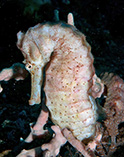| Family: |
Syngnathidae (Pipefishes and seahorses), subfamily: Syngnathinae |
| Max. size: |
28 cm OT (male/unsexed) |
| Environment: |
bathydemersal; marine; depth range 1 - 150 m, non-migratory |
| Distribution: |
Indo-West Pacific: Tanzania up to the Red Sea and New Caledonia; north to Japan, south to Australia. |
| Diagnosis: |
Dorsal spines (total): 0-0; Dorsal soft rays (total): 17-19. Description: (based on 22 specimens): Adult height: 15.0-25.0cm. Rings: 11+40 (39-41). Snout length: 2.1 (2.0-2.3) in head length. Dorsal fin rays: 18 (17-19) covering 2+1 rings. Pectoral fin rays: 18 (17-19). Coronet: high, with five short spines, and high plate in front of coronet. Spines: low and rounded, slightly better developed in younger specimens, but still blunt-tipped. Other distinctive characters: long, slightly backwards pointing, rounded cheek spine; deep head; narrow body; thick body rings; prominent, rounded eye spine; thick snout. Color pattern: pale, often with tiny white spots running in vertical lines, but otherwise uniform in color. Young H. kelloggi look very similar to H. spinosissimus. |
| Biology: |
Deep water species, associated with corals (Ref. 52034). Ovoviviparous (Ref. 205). The male carries the eggs in a brood pouch which is found under the tail (Ref. 205). |
| IUCN Red List Status: |
Vulnerable (VU); Date assessed: 27 January 2017 (A2cd) Ref. (130435)
|
| Threat to humans: |
harmless |
Source and more info: www.fishbase.org. For personal, classroom, and other internal use only. Not for publication.

